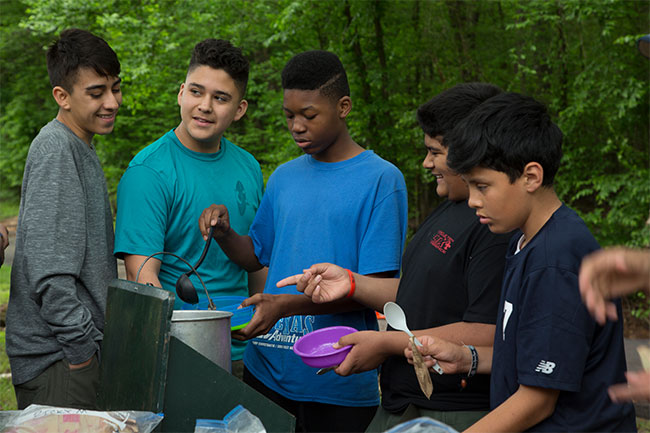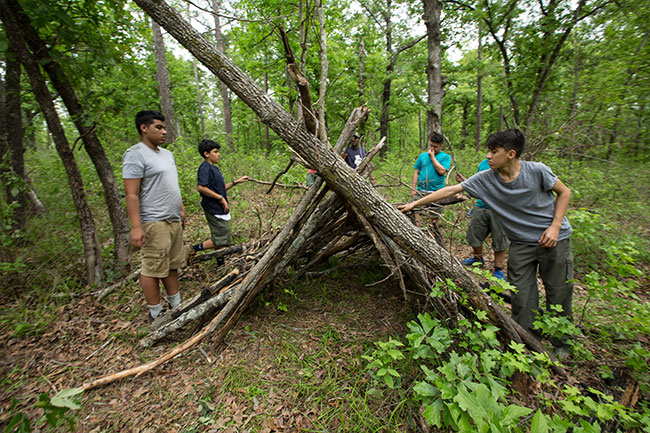Survival of the Fittest: Wilderness Survival Training
The most important thing to remember during a wilderness emergency is STOP:
• Stop and take care of your immediate safety.
• Think about what you should do.
• Observe your surroundings.
• Plan your next move.

The Scouts from Troop 2012 in Dallas, Texas, aren’t in a real emergency. They’ve gone camping in the East Texas wilderness, which makes this the perfect time to practice STOP and everything else that goes into wilderness survival training.
“You never know when you might be in a situation when you need to have these skills,” 12-year-old Victor Collazo says.
The best time to practice your wilderness survival skills is before you are faced with a real life-or-death situation. That’s why Troop 2012 conducts this campout every year.
On Friday afternoon, the guys drive a couple of hours east to private land owned by the troop’s chartered organization. That night, they sleep in tents.
After that, it’s nonstop wilderness survival training for the next 36 or so hours.
“Wilderness survival really teaches the fundamentals of being outdoors,” says Ricky Monroy, the 16-year-old senior patrol leader on this trip. “This is what Boy Scouts is.”
Building Shelter

One of the most important aspects to surviving in the wild is having proper shelter. If it’s hot outside, you need protection from the sun. If it’s cold, you need protection from the wind.
The Scouts from Troop 2012 start working on their A-frame lean-to shelters first thing Saturday morning.
“Those are kind of hard,” 14-year-old Sebastian Hernandez says. “It takes around six hours.”
The first step is to find a fallen limb large and strong enough to serve as the shelter’s “backbone.” It must be big enough to support the weight of dozens of smaller branches that act like the shelter’s “ribs.”
Once the basic frame is up, the Scouts throw leaves and smaller twigs on top to provide insulation from the elements. When built correctly, a lean-to made of branches, leaves and twigs can keep you safe, warm and dry.
Remember those tents from Friday night? On Saturday, they don’t need them. They spend the night in their new emergency shelters.
“It’s fun to create your own little hut to sleep in,” Victor says.
Fire Men
Another key wilderness survival skill is building a fire. When built properly and safely, a fire not only keeps you warm, but it can also signal your location to others.
The Scouts build a teepee-shaped fire, starting with tinder and kindling, and then moving on to larger sticks. Collecting the materials is the easy part. Getting the fire started isn’t.
These Scouts don’t use matches, fire starters or utility lighters. Instead, they use flint and steel. They hold the flint just above the tinder and strike it repeatedly with the steel, sending sparks toward the tinder.
And by “repeatedly,” we mean over and over and over and over.
“You can’t just rush into it,” Ricky says. “Sometimes it takes two hours. If they don’t succeed, they have to try again. They might get frustrated. But once they light it, they really love it. They want to keep it going.”
>To prove their fires are worthy, each Scout heats a pack of foil-wrapped veggies. That’s the easy part, and the reward is well worth it.
“I was proud of myself,” Victor says. “I wouldn’t have learned those skills if I wasn’t in the Boy Scouts.”
Preventing Emergencies
One of the best ways to deal with emergencies is to do everything you can to decrease the chances of them happening in the first place. Before you head out on a Scout trip, keep in mind the BSA’s Trek Safely plan:
- Make sure your group includes trusted adults who can take responsibility for the group’s safety.
- Keep yourself in good physical condition.
- Make sure your trip plan matches the skillset of your group.
- Use the right gear.
- Leave details of your trip with someone back home.
- Keep an eye on the weather.
- Make sure everyone knows the rules.




















This was very hekpful! Thanks!
We did this at camp silverado at silver lake.